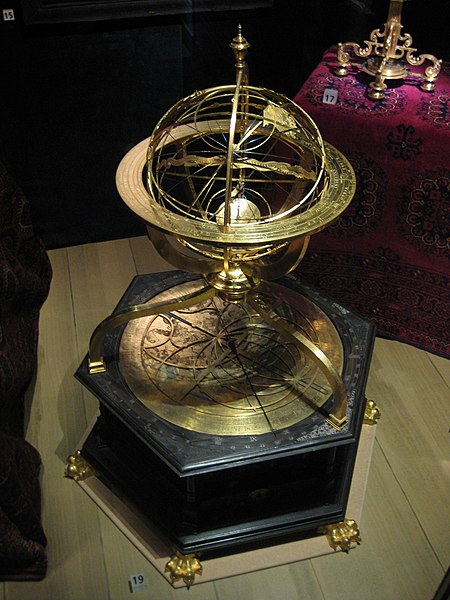An armillary sphere is a model of objects in the sky, consisting of a spherical framework of rings, centered on Earth or the Sun, that represent lines of celestial longitude and latitude and other astronomically important features, such as the ecliptic. As such, it differs from a celestial globe, which is a smooth sphere whose principal purpose is to map the constellations. It was invented separately, in ancient China possibly as early as the 4th century BC and ancient Greece during the 3rd century BC, with later uses in the Islamic world and Medieval Europe.
Jost Bürgi and Antonius Eisenhoit: Armillary sphere with astronomical clock, made in 1585 in Kassel, now at Nordiska Museet in Stockholm
Chinese Armillary sphere at Beijing Capital International Airport Ziwei Chenheng Aug-2010
The original diagram of Chinese scientist Su Song's book of 1092 showing the inner workings of his clocktower; a mechanically rotated armillary sphere crowns the top.
Armillary sphere at Beijing Ancient Observatory, replica of an original from the Ming dynasty
An astrolabe is an astronomical instrument dating to ancient times. It serves as a star chart and physical model of visible heavenly bodies. Its various functions also make it an elaborate inclinometer and an analog calculation device capable of working out several kinds of problems in astronomy. In its simplest form it is a metal disc with a pattern of wires, cutouts, and perforations that allows a user to calculate astronomical positions precisely. It is able to measure the altitude above the horizon of a celestial body, day or night; it can be used to identify stars or planets, to determine local latitude given local time, to survey, or to triangulate. It was used in classical antiquity, the Islamic Golden Age, the European Middle Ages and the Age of Discovery for all these purposes.
North African, 9th century AD, Planispheric Astrolabe. Khalili Collection.
A modern astrolabe made in Tabriz, Iran in 2013.
16th-century woodcut of measurement of a building's height with an astrolabe
Armillary Sphere mosaic from the Casa di Leada at Soluntum in Sicily.








